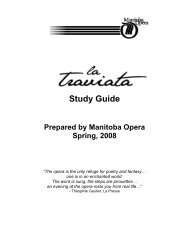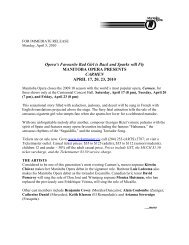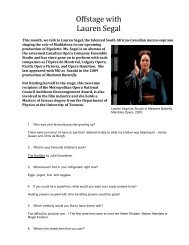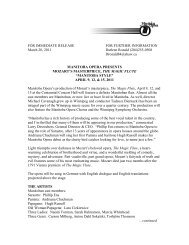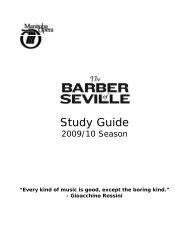Create successful ePaper yourself
Turn your PDF publications into a flip-book with our unique Google optimized e-Paper software.
Bullfighting<br />
<strong>Carmen</strong> features a character named Escamillo who is a champion bullfighter. His<br />
famous aria, known as the “Toreador Song,” is one of the best known pieces in<br />
opera. Similar to professional athletes today, Escamillo is idolized by the crowd –<br />
and by <strong>Carmen</strong>.<br />
Bullfighting in Spain<br />
Bullfighting is considered an art form in Spain, and is intimately linked with<br />
the country’s history, art and culture. Today bullfighting is big business in<br />
Spain with the top matadores earning comparable salaries to the nation's top<br />
soccer stars and rock idols. It is very popular with several thousand Spaniards<br />
flocking to their local bull-ring each week.<br />
It is said that the total number of people watching bullfights in Spain reaches one million every<br />
year. Pressure groups attempt to lobby against bullfighting yet the King of Spain himself has been<br />
quoted as saying that the day the EU bans bullfighting is the day Spain leaves the EU.<br />
History of Bullfighting in Spain<br />
The spectacle of bullfighting has existed in one form or another since ancient days. For example,<br />
a contest of some sort is depicted in a wall painting unearthed at<br />
Knossos in Crete, dating from about 2000 BC. It shows male and<br />
female acrobats confronting a bull, grabbing its horns as it<br />
charges, and vaulting over its back.<br />
Bullfighting can be traced back to ancient days. They were<br />
popular spectacles in ancient Rome, but it was in the Iberian<br />
Peninsula that these contests were fully developed by the Moors<br />
from North Africa who overran Andalucia in AD 711. Bullfighting<br />
developed into a ritualistic occasion observed in connection with<br />
feast days, on which the conquering Moors, mounted on highly trained horses, confronted and<br />
killed the bulls.<br />
As bullfighting developed, the men on foot, who by their capework aided the horsemen in<br />
positioning the bulls, began to draw more attention from the crowd, and the modern corrida<br />
began to take form. Today the bullfight is much the same as it has been since about 1726, when<br />
Francisco Romero of Ronda, Spain, introduced the estoque (the sword) and the muleta (the<br />
small, more easily wielded worsted cape used in the last part of the fight).<br />
Bull fighting: The Spectacle<br />
Six bulls, to be killed by three matadors, are usually required for one afternoon's corrida, and<br />
each encounter lasts about 15 minutes. At the appointed time, generally 5 PM, the three<br />
matadors, each followed by their assistants, the banderilleros and the picadors, march into the<br />
ring to the accompaniment of traditional paso doble (“march rhythm”) music. The matadors (the<br />
term toreador, popularized by the French opera <strong>Carmen</strong>, is erroneous usage) are the stars of<br />
the show. They wear a distinctive costume, consisting of a silk jacket heavily embroidered in gold,<br />
skintight trousers, and a montera (a bicorne hat). A traje de luces (“suit of lights”), as it is<br />
known, can cost many thousands of dollars; a top matador must have at least six of them a<br />
season.<br />
When a bull first comes into the arena out of the toril, or bull pen gate, the matador greets it<br />
with a series of manoeuvres, or passes, with a large cape; these passes are usually verónicas,<br />
28



